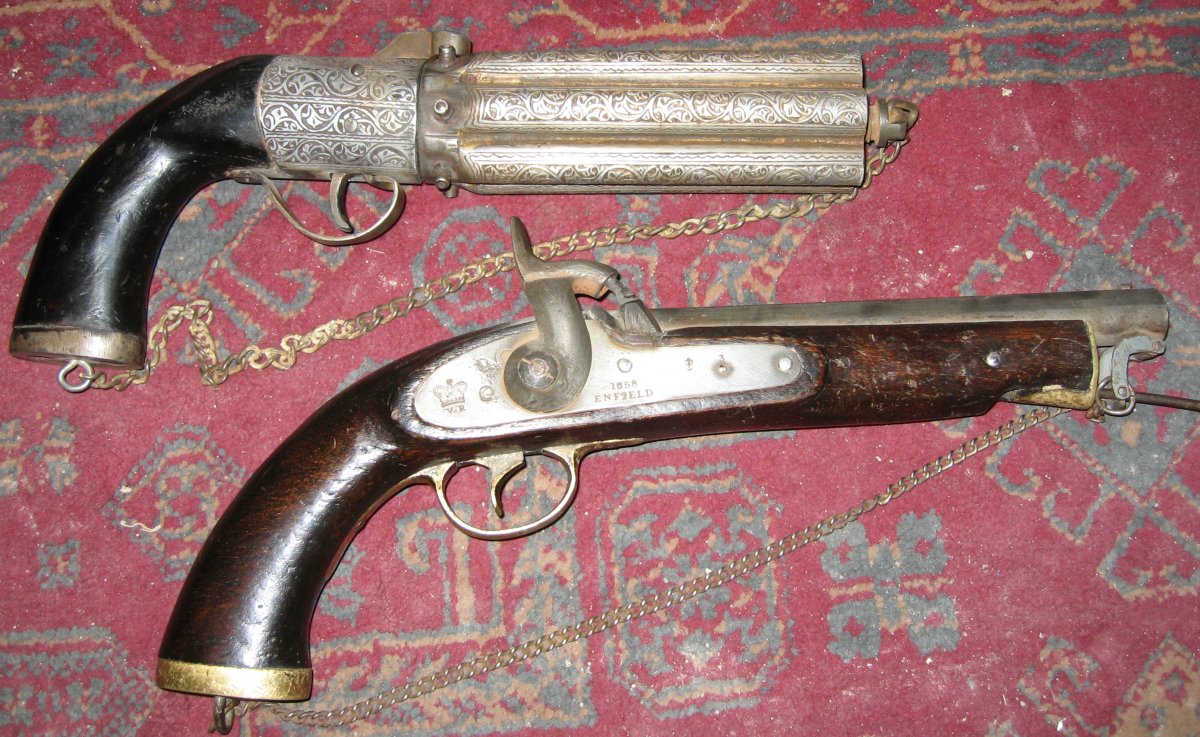
Old Guns from Afghanistan---or are they?)
If you are considering purchase of an "old gun" in Afghanistan, buy it as something that will be meaningful as a souvenir of your time there,
not with the hope that you will be able to resell it at a profit.
Most of the guns being sold seem to be recently manufactured to meet the demand from Americans stationed there.
Click here to read about the gun making operations at Darra to understand the nature of the business that has been going on there for centuries.
Below are some tips on what to look for when purchasing an "old gun."
|
After receiving numerous inquiries from troops in Afghanistan, we decided to post a few tips on things to look for to tell if a gun is old, or a recently made replica for the tourist market. The photos were received from troops in country asking about guns the were looking at, or had purchased. You should also be aware that some modern cartridge guns have been stamped with markings indicating manufacture in the 1800s- one example being a circa 1940 Russian rifle marked as being made in 1885. A sucker bought it---and left it at the customs office when they determined it did not meet the "made in 1898 or earlier" criteria.
Two Old Pistols

Both are recently made. The pepperbox is kind of cute, but definitely a crude local copy imitating the general type. On originals, the barrels were made from a solid piece of iron/steel, while this one looks like they brazed together several individually made barrels. Many other features point to it being locally made.
The single shot is extremely crude in so many areas. It generally copies a style of pistol that was made in England for colonial use in the 1850s, but generally for the East India Company, not by Enfield. A somewhat similar Model 1842 was made at Enfield.
Here are a few details to look for:
(a) workmanship on the trigger and trigger guard. The locals seem to consider these unimportant and spend little time on them. Originals had finely finished triggers and guards, with smooth, flowing lines.
(b) The "snail" on the barrel for the nipple is all wrong, and the fit between the bottom of the snail and the lock is horrible. They should be a tight fit, not filled with some sort of wood filler.
(c) When guns age, the iron/steel oxidizes slowly in a dark, almost black color. Artificial aging with acids or salt water usually leaves bright red rust.
(d) Among the various markings you will note that many of the letters/numbers have the "serifs" (ENFIELD 1858) while others do not (ENFIELD 1858). The fonts in use in the 19th century almost always had the serifs.
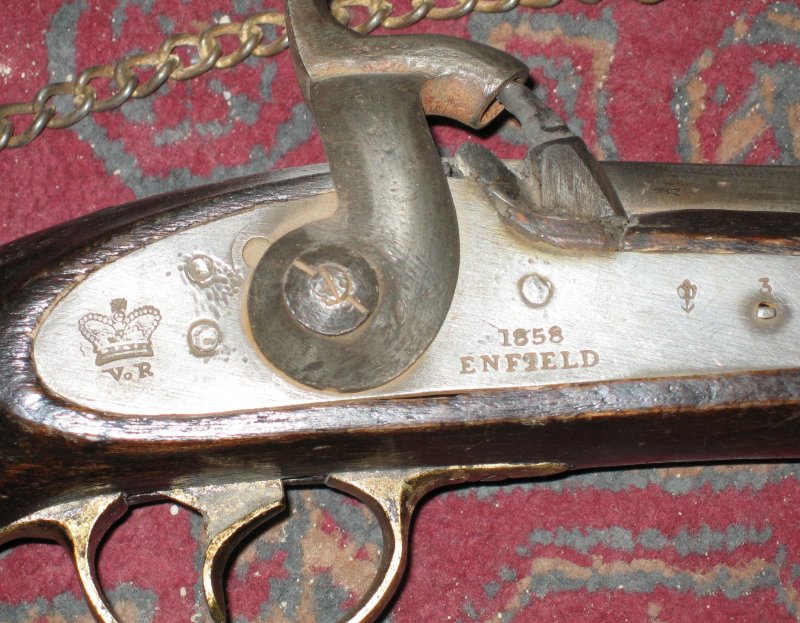
I have attached photos of two Enfield muskets. Many of the features are nearly identical to those on the single shot "Enfield" pistols, except for size, and if you compare the features you will get a better idea of the differences.
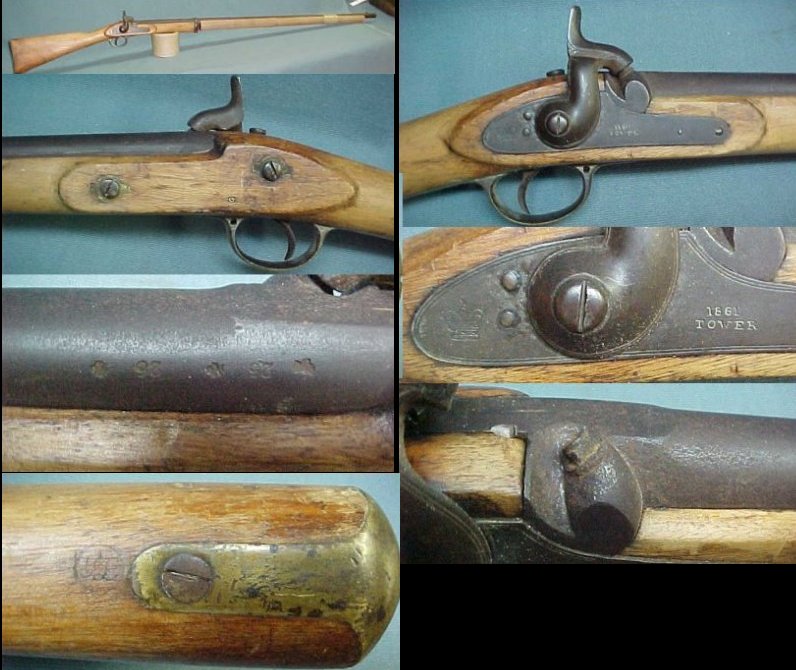
Note the fit of the buttplate and the loc, and barrel in the stock, with no filler gunk. There is a neat border line around the end of hte lockplate and the hammer, found on nearly all English guns, circa 1750-1875. Note that the hammer strikes the nipple squarely (although the top portion of the nipple is broken off in the picture above). THe wood here has been lightly stripped, but still has some patina.
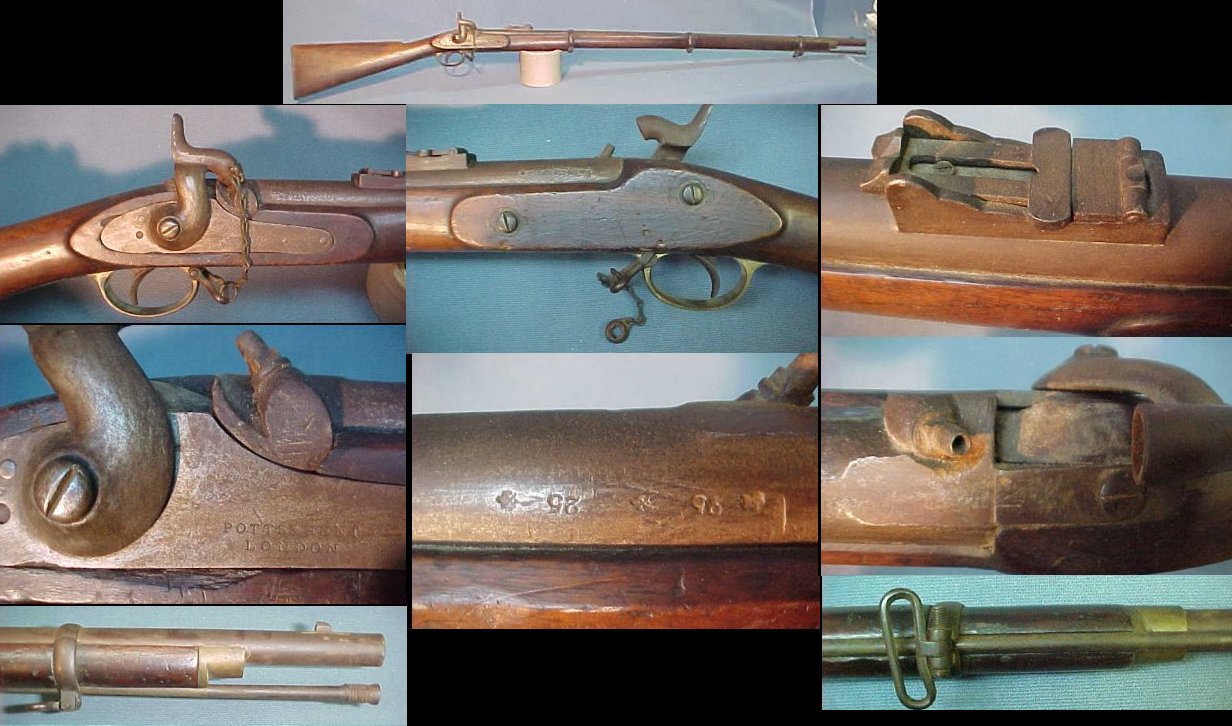 Another Pattern 1853 Enfield .577 caliber muzzle loading musket. The parts fit well, have aged uniformly. The wood behind the nipple has been eroded or rotted away from the effects of firing with percussionc aps which used very harmful fulminate of mercury. The wood around the lockplate has some chips from careless disassembly, and the upper band is bent, but you can imagine what they looked like before being damaged. . Note the tiny Birmingham proof marks on the barrel, with the 25 indicating the bore diameter. Both the Tower and Potts & Hunt locks show the letters with serifs, and the neatness in alignment.
Another Pattern 1853 Enfield .577 caliber muzzle loading musket. The parts fit well, have aged uniformly. The wood behind the nipple has been eroded or rotted away from the effects of firing with percussionc aps which used very harmful fulminate of mercury. The wood around the lockplate has some chips from careless disassembly, and the upper band is bent, but you can imagine what they looked like before being damaged. . Note the tiny Birmingham proof marks on the barrel, with the 25 indicating the bore diameter. Both the Tower and Potts & Hunt locks show the letters with serifs, and the neatness in alignment.
Another "Enfield" pistol- higher quality
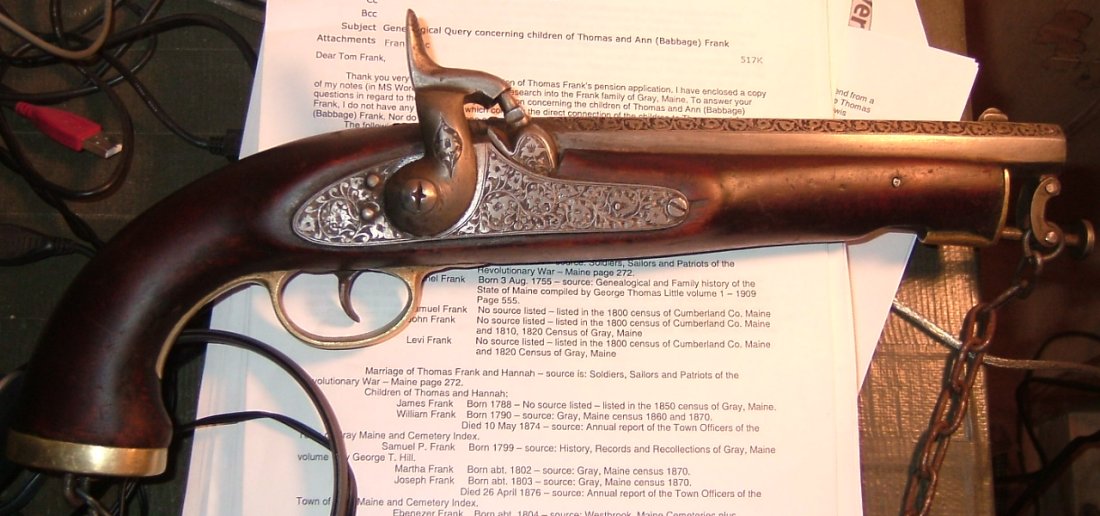
This is much nicer workmanship than many of the guns being offered. The engraving on the barrel is nicely done. It is similar to the "Enfield" above, but note the much better workmanship throughout. While not an "old" gun, this is a nice souvenir piece, and reflects credit upon the craftsman who made it, probably with only hand tools. Reportedly the purchaser paid $100 for it in early 2006.
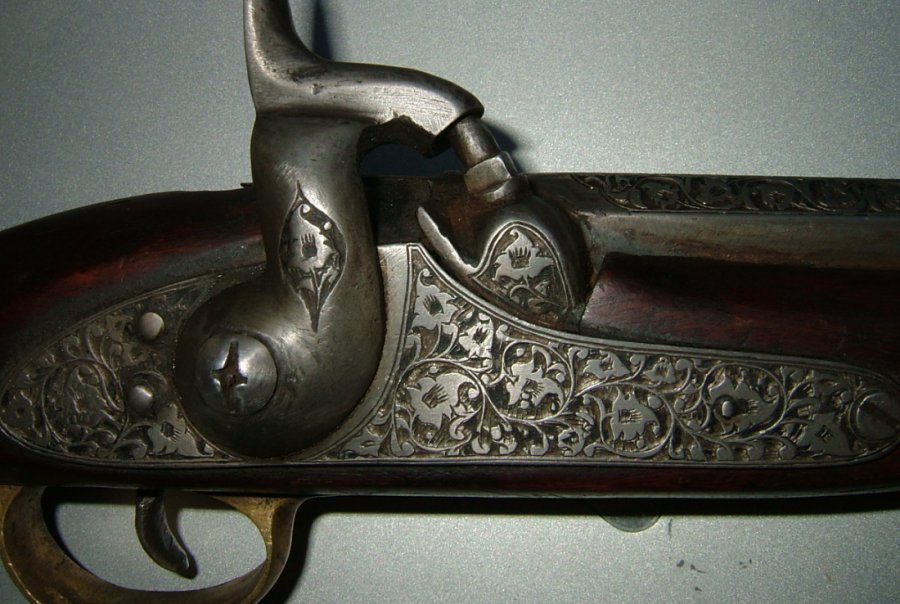
Nice looking work, but note that the hammer does not come down square on the nipple, and after firing a few times the nipple would probably be snapped off.
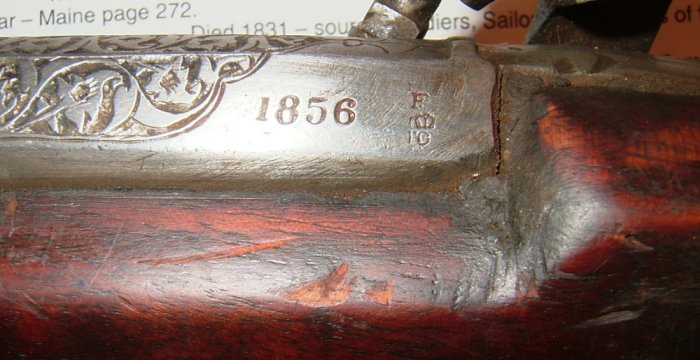
Now, notice the wood, stained fairly dark, but no real patina. The fit of the metal parts is not as bad as some, but there is a lot of filler material (epoxy, glue and sawdust, camel dung...?) filling the gaps. The "1" in 1856 is a different height than the other numbers. The proof marks are wrong for an Enfield made gun. Convincing looking markings at first glance.
Three New "Old Pistols"
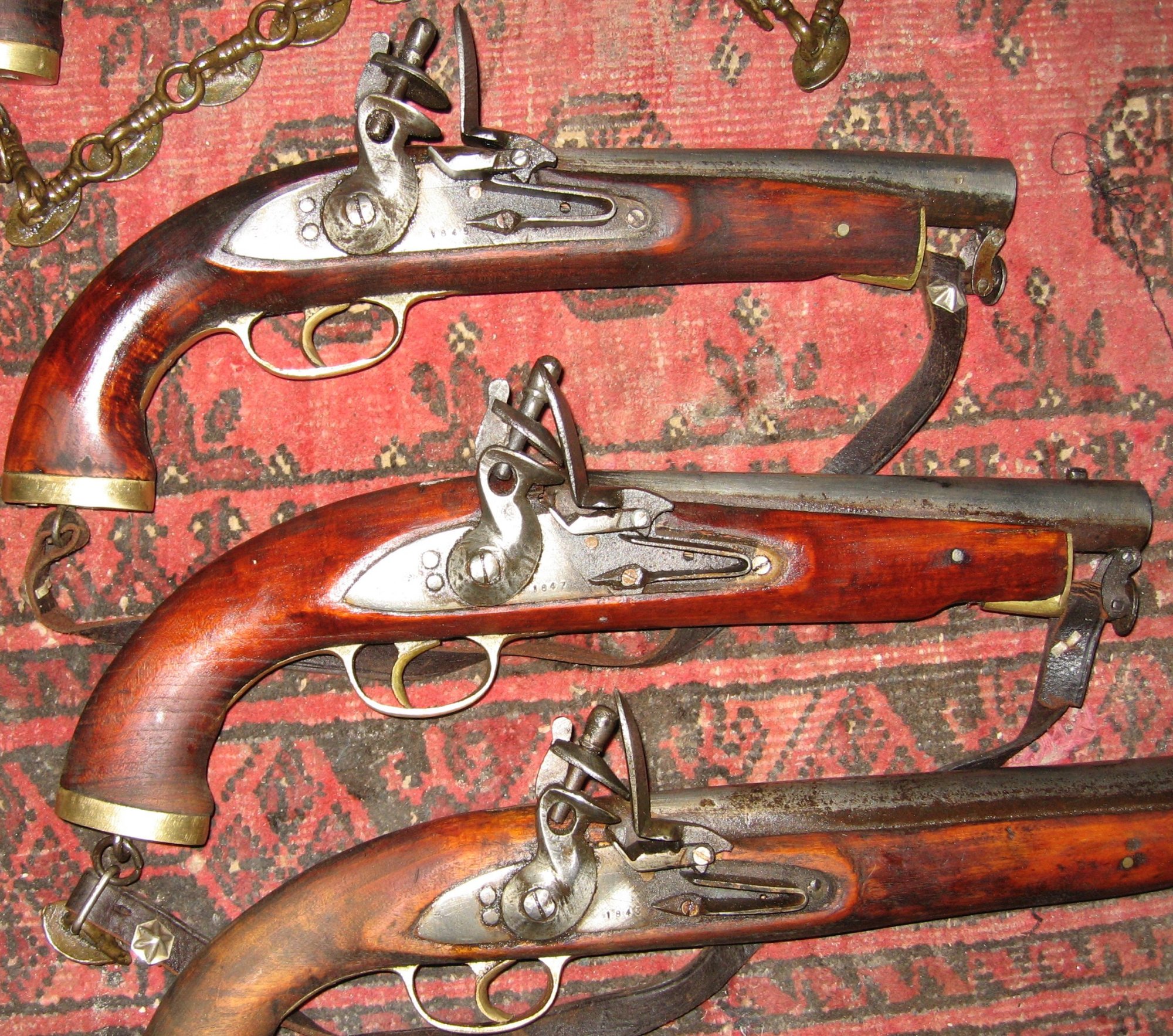
Pistols are all newly made, not really very good quality either. Note amount of filler gunk between metal and wood, and the extreme crudeness of the triggers. Brass triggers were (almost) never used on original guns. The numbers (which are intended to look like dates) are sans-serif type. The wood looks freshly worked, and has a coat of stain but no real patina from age. Compare the details of the lock parts with the original flint locks on the Jezails ("Camel guns") at the end of this page.
Another "Pepperbox"
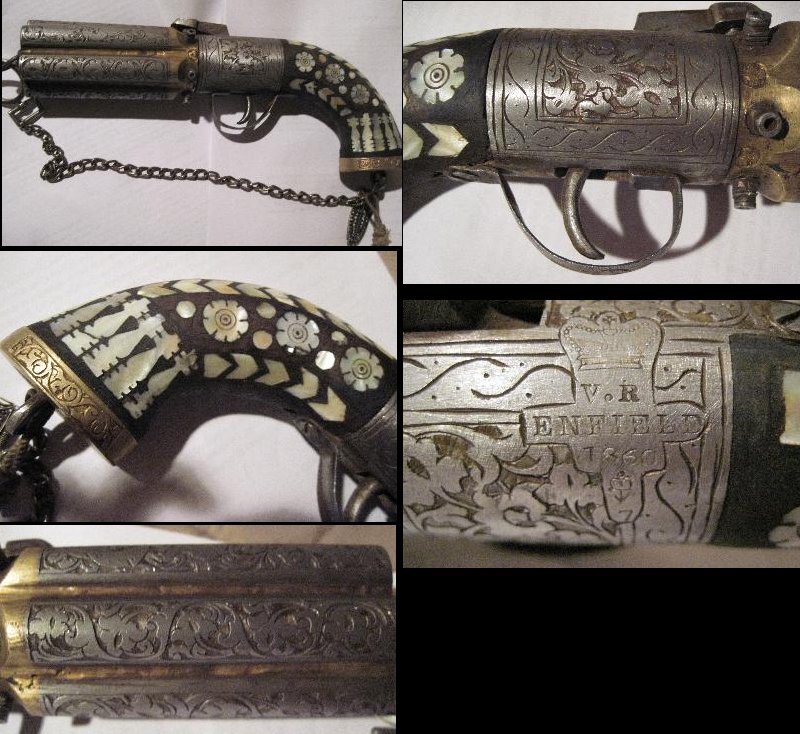
Cute, with very ornate, but crude workmanship. Note the V.R. ENFIELD 1860 markings. Apparently "Enfield" is used on guns like fakers mark "Rolex" on watches. Enfield never made any pepperboxes, so this is not only marked with fake markings, but not even an old gun. It can still be a nice souvenir, but not a rare collector prize, and definitley not a good investment for later resale.
Snider .577 caliber Breech Loading Rifle


The rifle is probably a genuine old one. It is a British "Snider" single shot breechloader which used .577 Snider caliber cartridges. Some were converted from older muzzle loading muskets starting about 1867, and some were newly made as breechloaders. These were replaced by the Martini Henry style rifles about 1874.
This one MAY be a local copy, but is probably a real British made rifle. Note the workmanship on the trigger, fit between the metal and wood. Note that the light colored English walnut has a deep patina with the grain still showing, not an all-concealing coat of dark stain smeared on top of freshly worked wood salvaged from pallets. Note how the wood has shrunk over the years and the buttplate at the bottom is slightly above the level of the wood. Sling swivels look nice and symmetrical, machine made, not hammered and filed. The rear sight markings are neatly aligned, machine stamped, not crooked hand stamps, and the sight leaf fits well. The locations of the screws in the lock look a little bit off for genuine Enfield work, so while I am convinced it is "old" I am not certain that it is all British made. The lock may or may not be a replacement.
The Sniders and the muzzle loading Enfields were made in several different lengths for infantry, cavalry and artillery and some other oddball types, as well as special models for colonial troops. I am not sure which one this is, but think it is a long infantry rifle cut down to a handier size. Usually the shorter versions had a stud on the right side of the barrel about 4-5 inches from the muzzle for the handle of a sword bayonet. It may have been removed, if it was made in this length. But the band spacing looks wrong for a short version, so more likely it was cut down and the front sight relocated. Cleaning rod looks like a replacement.
While an "old gun" and a great souvenir, collector value is modest, perhaps a few hundred dollars, but probably not over $300-450 on a very good day with a very gullible buyer. $200-300 would be more like it.
A Jezail-- also known as a "Camel Gun"

These have several names, but collectors lump them all into the category of "Camel Guns. Variations of this theme seem to have been popular amongst the natives from North Africa, across the Egyptian and Arab regions and into the region now known as Iran, down through the 'stans and India.
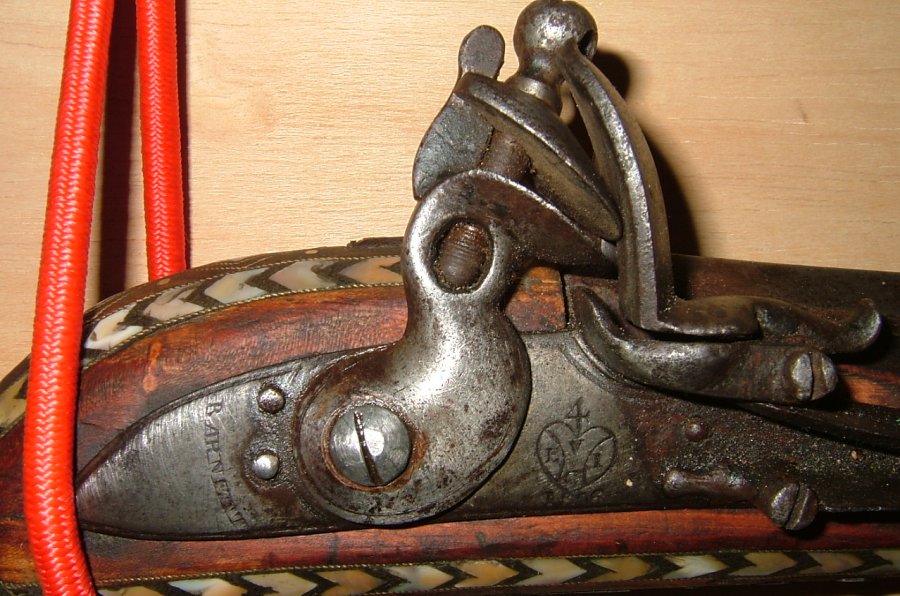
The lock on this one looks real. Note the border lines around the edge of the lockplate and the hammer, the engraved (not stamped) maker name and the heart shaped insignia of the British East India Company which sold arms in the colonial region that is now India, Pakistan and Afghanistan. The lock shows signs of genuine age, although it has been vigorously cleaned recently. The Lock was probably made circa 1790-1820. The rest of the gun was assembled some time later, in the region, but we could only guess as a date, last century or last month?
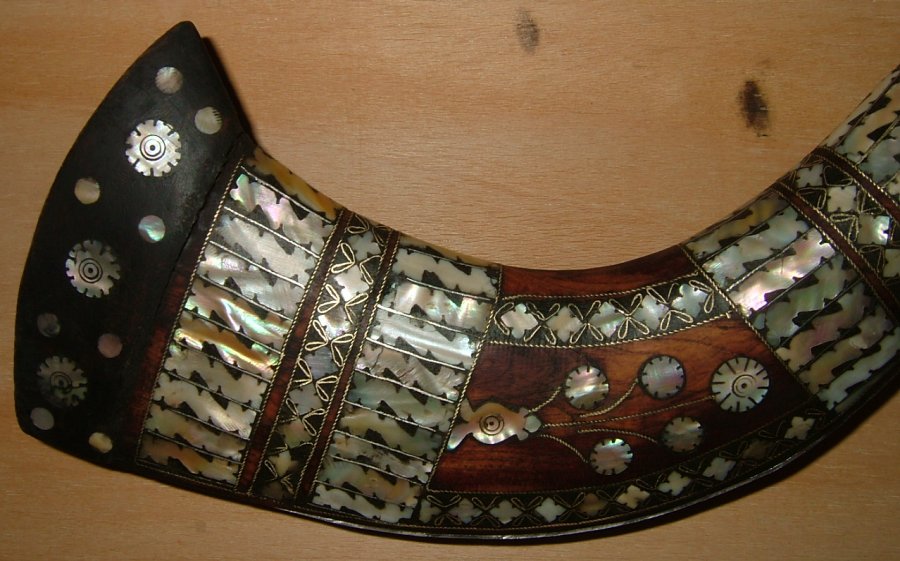
The buttstock decorations are flashy, but workmanship is crude, and the wood looks very fresh. My guess is that it has been heavily cleaned recently, perhaps with the decorations added at that time. Note the generous amounts of the coarse black filler used to anchor the inlays in place, similar to that on some of the pistols shown above. If it is a 100 year old gun, it is truly amazing that none of the inlays have fallen out over that time, or.....
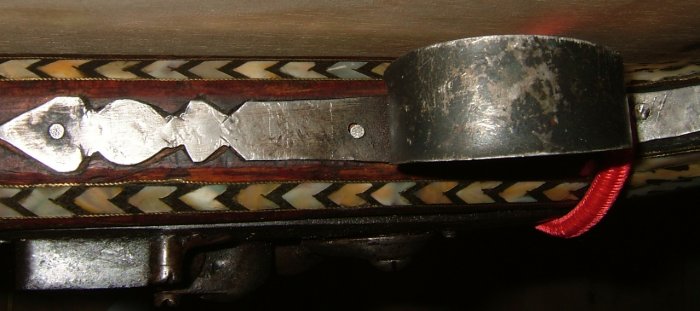
The trigger guard is obviously a recent replacement crudely nailed on. Definitely not original, or maybe the whole gun was assembled recently.
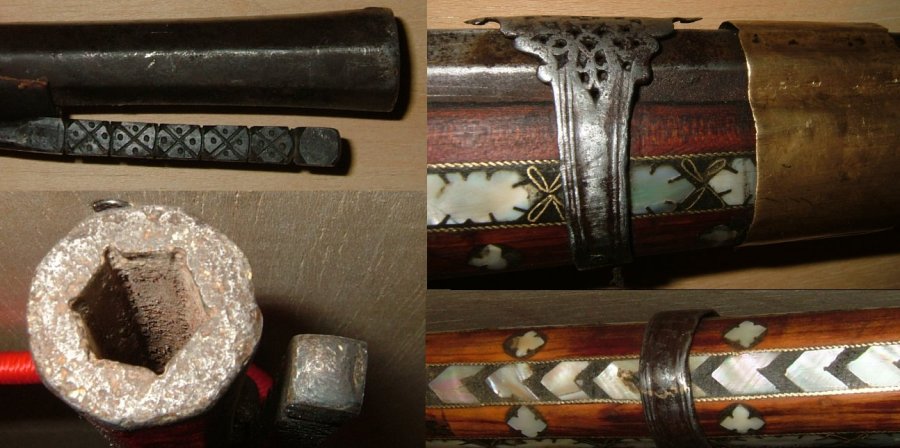
Some more details. The barrel seems to show real age, and the rifling is fairly typical of the early 19th Century. The ramrod is probably a recently made replacement, but looks good. One of the barrel bands shows good workmanship with the piercings and file work but the fit is horrible, probably from being moved during a recent cleaning. Overall, while the gun itself seems old, the lavish decorations and apparently recently cleaned stock indicate that the decorations may have been recently added to make it fancier and higher priced.
Another Camel Gun
 THis one is a lot fancier than the other one, and it seems to be more authentic, due to the workmanship, and seemingly better fit of the bands.The sling and brush/chain attachments are recent additions. Such accessories catch the eye of buyers and distract them from looking too closely at the gun itself.
THis one is a lot fancier than the other one, and it seems to be more authentic, due to the workmanship, and seemingly better fit of the bands.The sling and brush/chain attachments are recent additions. Such accessories catch the eye of buyers and distract them from looking too closely at the gun itself.
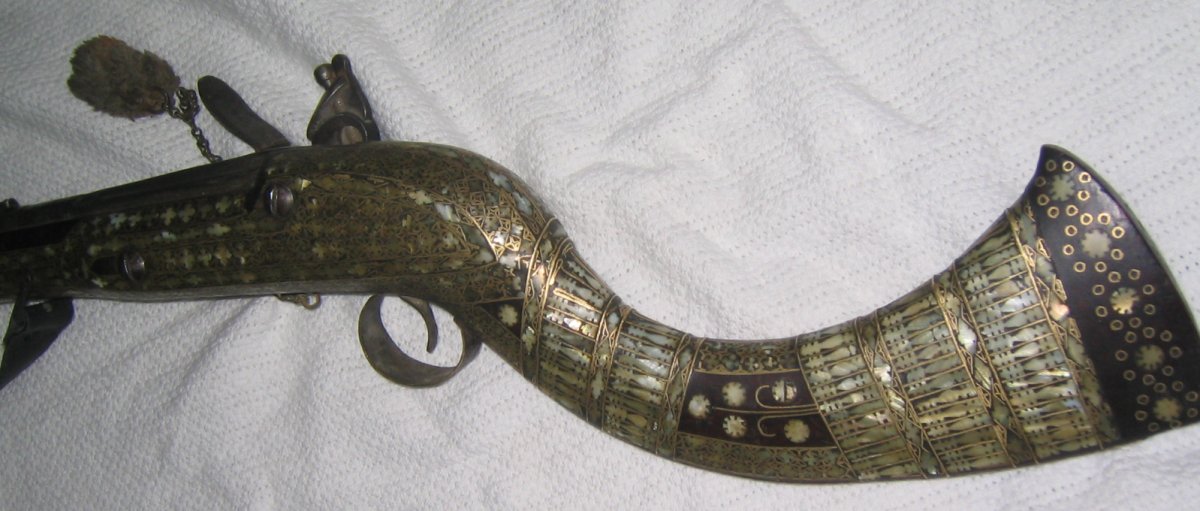 Very nice workmanship. If not old, at least it is well done, by someone with some artistic taste (and MANY HOURS of time!).
Very nice workmanship. If not old, at least it is well done, by someone with some artistic taste (and MANY HOURS of time!).
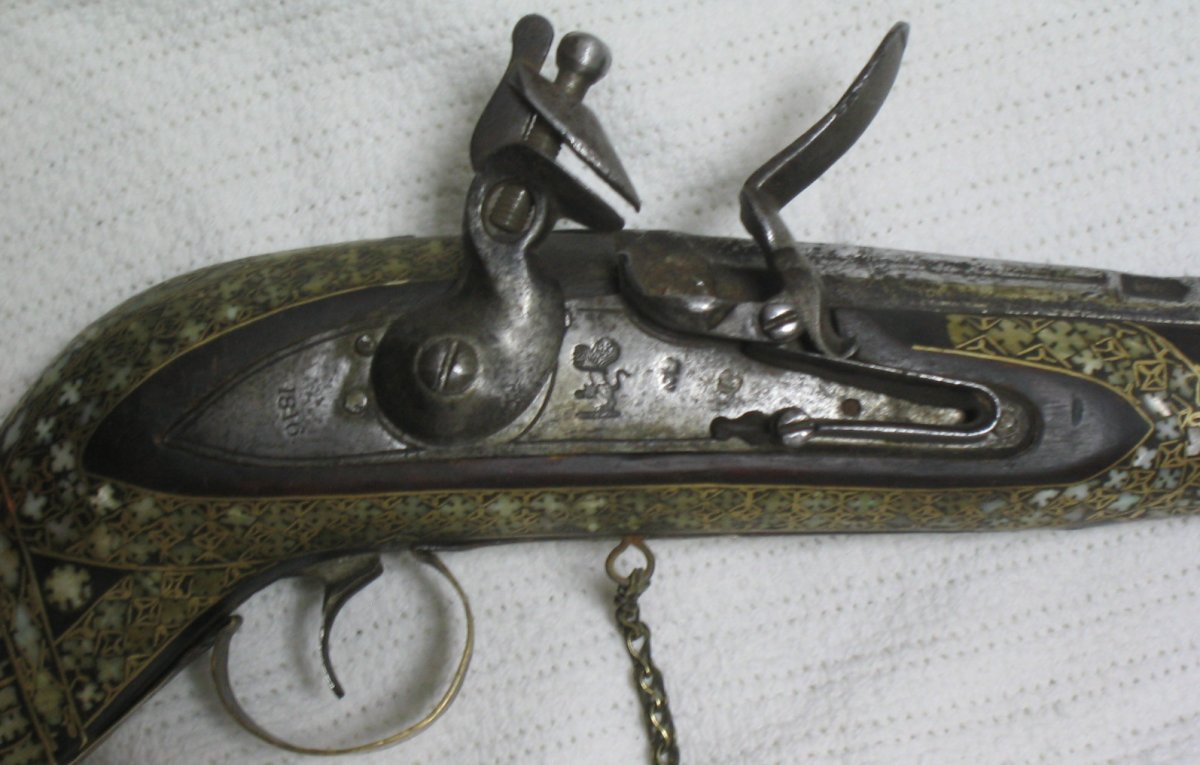 The lock on this one is from a British
East India Company musket from 1816, after they changed to a Lion logo. The lock is certainly an original, and
while the age of the rest of the gun is hard to determine, it may be old, or
even very old.
The lock on this one is from a British
East India Company musket from 1816, after they changed to a Lion logo. The lock is certainly an original, and
while the age of the rest of the gun is hard to determine, it may be old, or
even very old.
In any case, it is a very nice quality example of the indigenous style
arms, showing a mix (or clash) of local culture and the colonial culture and
technology. A great souvenir.
The only problem with these "camel guns" is the awkward shape makes them
extremely difficult to ship unless in a fairly solid case of some sort. It
would help to remove the screws holding the hammer and frizzen ("L" shaped
thin the flint hits) which will reduce the height a little, and reduce the
chance of damage. The crooked portion of the stock is a real weak area, so
be careful
Value in the U.S. on the collector market is modest for most of these,
often in the $200-400 range as decorative items, and slow to sell at any
price.
|
Copyright 2007-2010. All rights reserved. OldGuns.net
Visit ArmsCollectors.com main page
Revised 28 July 2010